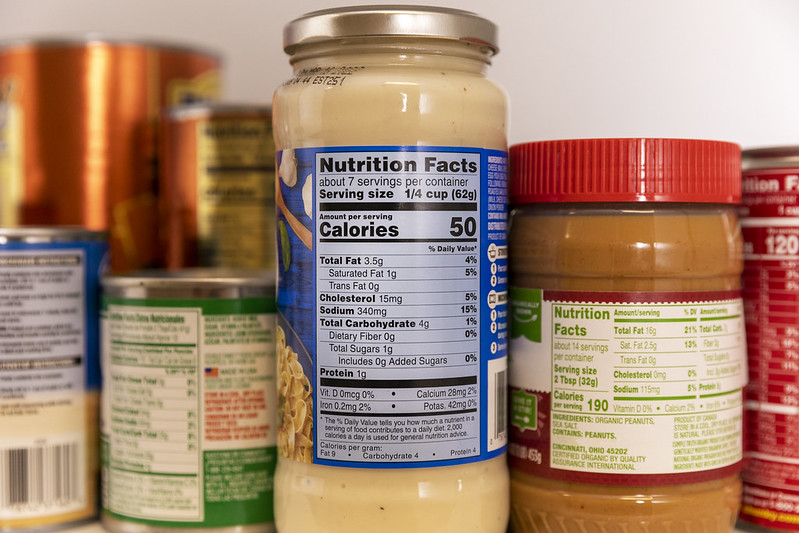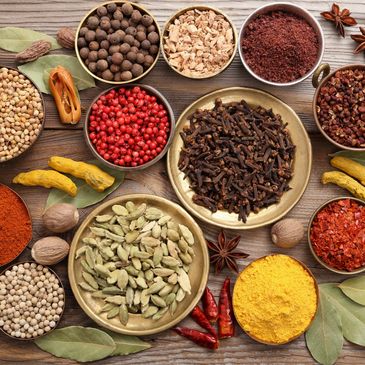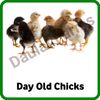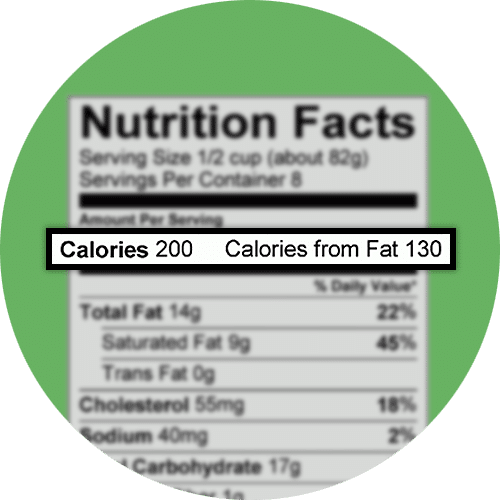38 how to read calories on food labels south africa
Food labels part 3: Nutrient counting and calorie math. And they may be correct: Researchers have discovered that restaurant food labels can be off by 100-300 calories. Some ingredients, such as mono- and diglycerides, which are also found in processed foods, aren't counted towards calorie counts because they're not technically triglycerides (aka fats). Researchers and dieticians argue it's high time South... New local research shows that a simple black and white warning label — similar to that used in many Latin American countries — could help South Africans quickly identify foods high in sugar ...
Food Labeling Basics - Food Quality & Safety Food manufacturers with $10 million or more in annual sales will need to use the new label design by July 26, 2018; smaller manufacturers will have an additional year to comply. The ingredients statement must follow the Nutrition Facts Panel and must list all of the ingredients in the product in descending order of predominance by weight.

How to read calories on food labels south africa
Calories Are Now Listed on Menus, but Sugar and Protein Matter Too It's also important to look at key things like sugar and protein content. In glaring black-and-white block letters on the side of your favorite cereal, they vie for your attention: calories.... How to read food labels | Woolworths.co.za In South Africa, the total energy of a product is indicated in kilojoules (kJ). If your product indicates 'calories,' one calorie is equal to 4.2 kJ. To maintain a healthy weight, the energy from your food and beverages must balance with your total energy expenditure. If you take in more kJ per day than your body needs, you will likely gain weight. How to read food labels | All4Women Calories (kcal) and kilojoules (kJ) are both units for measuring the energy found in food. To convert: 1 calorie equals 4,184 kilojoules. You should aim to consume the same amount of energy per day that you use up in a day. According to the World Health Organisation, the average energy intake for adults is 8 400 kilojoules (kJ) per day.
How to read calories on food labels south africa. South African consumers' perceptions of front-of-package warning labels ... In South Africa warning labels may improve consumer understanding of nutrition information and assist consumers in determining the nutritional quality of packaged foods and drinks. How to understand food labels - Eat For Health The Nutrition Information Panel on a food label offers the simplest and easiest way to choose foods with less saturated fat, salt (sodium), added sugars and kilojoules, and more fibre. It can also be used to decide how large one serve of a food group choice or discretionary food would be and whether it's worth the kilojoules. South African consumers' perceptions of front-of-package warning labels ... Front-of-package labeling (FOPL) is a policy tool that helps consumers to make informed food choices. South Africa has not yet implemented this labeling system. The aim of this study was therefore to explore adult South African consumers' perceptions of front-of-package warning labels on foods and non-alcoholic beverages (referred to as drinks in this paper) and their insights into features ... How to read food labels | Health24 - News24 The standard unit of measurement for food energy is kilojoules in South Africa. Product labels may represent the energy information in both kilojoules and calories (1 calorie (kcal) = 4.18 kilojoules).
The mystery of food labels - Insurance Chat Rogaly adds that there are other health considerations when reading food labels. While the fat and calorie content is important, other ingredients, like sodium, can affect how healthy a product is, or isn't. "Food labels can sometimes be confusing, especially if the front of the product proclaims that it's low in sodium but the ... Food Label guide to help conscientious consumers - A Greener World Bloomberg highlights Food Labels Exposed as one of the most helpful food guide for shopping, cooking and eating better: "Understanding the multitude of labels on animal products shouldn't require an explanatory guide—but having one sure makes it easier.. Alternet explains how Food Labels Exposed helps consumers bridge the information gap: "A Greener World, a nonprofit that works to ... Labelling - FoodFacts - Food Advisory Consumer Service Food labelling: A brief overview for consumers In South Africa there are many regulations which relate to the production, marketing and labelling of food to protect the consumer. ... If the nutritional table has been indicated on the label, whether voluntarily by the manufacturer or due to the fact that a claim has been made on the label, the ... Foods and Brands in South Africa - FatSecret Different types of breads and cereals like bagels, wraps, rye, wheat bread and oatmeal. more... Cheese, Milk & Dairy. Cheese varieties and dairy products like cheddar, mozzarella, gouda, skim milk and yoghurt. more... Drinks. Hot and cold drinks like juices, soft drinks, smoothies, coffee, beer, wine and cocktails.
Understanding food labels 101 | Heart & Stroke Foundation | South Africa To understand the food label of a product and be able to distinguish between unhealthy and healthier options is one of the best ways to make sure that you and your family are buying and enjoying healthy food and drinks. Making a habit of always reading food labels and understanding what they mean will soon become second-nature with this 2-step ... Understanding Food Labels | The Nutrition Source | Harvard T.H. Chan ... The label lists the calorie amount for one serving of food. The serving size, also important but often unnoticed, is easily doubled or tripled when not paying attention to the serving size, quickly inflating the calories. Highlighting both of these values emphasizes their importance and relationship. Reading labels - WorkCare Wellness Centralised Site If you come across a product that is in calories, it can be converted to kJ using this easy calculation. 1 kJ is equal to 4.2kCal, therefore 500kJ converted to calories is (500 kJ / 4.2 = 119 calories) and to go from calories to kJ you multiply by 4.2, therefore (119 kCal / cal x 4.2 = 500 kJ). Now that we have an energy value what does it mean? Mandatory Requirements For Food Labels in South Africa Nutritional Information The R429 bill requires all caloric values to appear on food labels in an effort to make consumers more aware of what they are putting into their bodies and of their daily energy intake. Net Contents This is the mass of product in the packaging. It could be in millilitres, grams or kilograms depending on the product.
Consumers' knowledge of food label information: an ... - Cambridge Core Consumers are becoming more health conscious and prefer to have nutrition information available during food purchasing (Reference Lando and Labiner-Wolf 1).Diet and nutrition are important factors to lower the risks of many chronic diseases of lifestyle (Reference Rosell, Appleby and Key 2), which endorses the link between nutrition and health (Reference Reid 3).
How to decode a food label - BBC Future Generally though, most labels feature an ingredient list and some information about the product's nutritional value: calories, fat, sugars, salt and so on. In recent decades, manufacturers have...

An assessment of nutrition information on front of pack labels and healthiness of foods in the ...
2018-12 - Misleading labels and insidious ingredients - Wits University Only limited legislation protects us against incomprehensible, misleading and detrimental food labels. On the back of a cereal box, sugar as an ingredient is hidden in plain sight. Indeed, the cereals many South Africans eat for breakfast and consider "healthy", on closer inspection, have a significant amount of sugar masquerading as ...
Labeling Regulations - The Global Food Research Program The National Agency of Sanitary Surveillance published new regulations on nutrition labeling of packaged food products in October, 2020.They will go into effect in October, 2022 and will require front-of-package warning labels on packaged foods and beverages that exceed set levels of sugar, saturated fat, or sodium content per 100g (foods) or 100mL (beverages).
Calorie Labels Can Be 20% Inaccurate. How to Keep up Your ... - Insider Copy Link. Nutrition labels can be inaccurate by up to 20% when it comes to listing calories, according to the FDA. This can be frustrating, but experts say it probably won't ruin an otherwise healthy diet. Sticking to whole, unprocessed foods can be a helpful strategy to avoid surprise calories in processed foods.
A dietitian explains how to read food labels - Health24 1. First look at the ingredient list The ingredients in a food product are listed in order of weight, with the largest quantity first. If a product has an ingredient that you are trying to cut down on on top of the list, you will know that it contains more of this ingredient than the ones at the bottom.
SFA | Understanding Food & Nutrition Labels To help identify a food, food labels must show: Name of the food; Name and address of local business entity; A common name or description of the food must be stated on the label to inform the purchaser of the true nature of the products. Sometimes, the "brand" name, "trade mark", "fancy" name, "sales" name or non-English names on food labels ...
Why South Africa should introduce mandatory labelling for fast foods It is important that the nutritional labelling is easily understood by all South African. Nutritional content In our research we described the nutritional information of standard fast-food items...
How to Understand Nutrition Labels - Insider Snapwire / Pexels Calories go hand in hand with serving size, since the nutrition label tells you how many calories are in one serving of that food.Ansel says it's good to be aware of how many calories you're consuming and how that fits into the amount of calories you need per day.. While this amount differs from person to person, according to Ansel, most people need between 1800-2000 calories ...
Know your food labels - Health-e News South Africa How to read a nutrition label: Light. Light products are processed to reduce either calories or fat. Some products are simply watered down. Check carefully to see if anything has been added instead — like sugar. Multigrain. This sounds very healthy but only means that a product contains more than one type of grain.
How to read food labels | All4Women Calories (kcal) and kilojoules (kJ) are both units for measuring the energy found in food. To convert: 1 calorie equals 4,184 kilojoules. You should aim to consume the same amount of energy per day that you use up in a day. According to the World Health Organisation, the average energy intake for adults is 8 400 kilojoules (kJ) per day.
How to read food labels | Woolworths.co.za In South Africa, the total energy of a product is indicated in kilojoules (kJ). If your product indicates 'calories,' one calorie is equal to 4.2 kJ. To maintain a healthy weight, the energy from your food and beverages must balance with your total energy expenditure. If you take in more kJ per day than your body needs, you will likely gain weight.
Calories Are Now Listed on Menus, but Sugar and Protein Matter Too It's also important to look at key things like sugar and protein content. In glaring black-and-white block letters on the side of your favorite cereal, they vie for your attention: calories....










Post a Comment for "38 how to read calories on food labels south africa"